All News
UMIACS Faculty Secure Funding for Projects Combining AI and Medicine

Three faculty members in the University of Maryland Institute for Advanced Computer Studies (UMIACS) have received funding to jumpstart research that combines powerful artificial intelligence tools with medical expertise in areas like aging, traumatic brain injury, mental illness, and more.
Michael Cummings, a professor of biology and director of the Center for Bioinformatics and Computational Biology, Philip Resnik, a professor of linguistics, and John Dickerson, an assistant professor of computer science, are involved with two of the four projects recently funded under a new initiative known as AI + Medicine for High Impact (AIM-HI).
The program—which joins faculty from the University of Maryland, College Park, with medical experts at the University of Maryland, Baltimore—provides up to $200K per year for each project, for a maximum of three years.
Officials hope that these cross-institutional efforts will lead to lead to scientific breakthroughs with the potential to secure larger federal awards as the research progresses.
“There is tremendous promise in each of the awards to attract additional external funding while making an impact to the state and region,” says Eric Chapman, the associate vice president for research development at the University of Maryland, College Park. “By leveraging our complementary cross-campus expertise, the state of Maryland will be able to tackle major health issues of societal importance.”
Cummings will work with experts in pharmaceutical sciences and anesthesiology at UMB to study aging and traumatic brain injury in mice. The researchers will develop an analytical framework to identify predictive functional relationships between changes in different metabolic parameters during aging.
The ultimate goal, Cummings says, is to generate testable hypotheses about mechanisms contributing to aging under both normal and disease conditions, which could lead to identification of appropriate interventions.
The researchers hope to transfer their initial findings to similar conditions seen in humans, which might eventually contribute toward treatments for age-related diseases like dementia and Alzheimer’s.
Resnik and Dickerson are partnering with Carol Espy-Wilson, a professor of electrical and computer engineering at UMD, and psychiatric experts at the School of Medicine in Baltimore lead by professor Deanna Kelly. The group is developing machine learning algorithms that can help assess mental illness online.
The goal of the project, Resnik says, is to establish a novel technological framework that integrates speech, video and text analysis in order to identify, assess and prioritize at-risk individuals.
The team’s initial research will focus on schizophrenia, major depressive disorder, and suicidal behaviors, but ultimately, they aim to develop a framework that can be broadly applied in other areas of healthcare.
–Story by Maria Herd
UMD Part of $10M NSF Expeditions in Computing Award to Develop Strategies to Thwart Disease Outbreaks

University of Maryland computing experts are partnering with a consortium of scientists from across the U.S. to deploy the latest advances in artificial intelligence, machine learning, supercomputing and social science data against epidemic outbreaks.
Funded by a $10 million grant from the National Science Foundation (NSF), the researchers are using these powerful technologies and tools to explore trends in globalization, anti-microbial resistance, urbanization and ecological pressures—factors that have converged to increase the risk of global pandemics like the COVID-19 crisis now wreaking havoc on populations and economies worldwide.
Professor Aravind Srinivasan, Distinguished University Professor Rita Colwell and Assistant Professor Abhinav Bhatele join faculty from 10 other universities on the Global Pervasive Computational Epidemiology project, which includes researchers from Princeton University, Yale University, Stanford University, the Massachusetts Institute of Technology and the University of Virginia, which is leading the multidisciplinary effort.
All three Maryland faculty have appointments in the University of Maryland Institute for Advanced Computer Studies.
While the concept of using modern technology to address the spread of global disease is not new, NSF officials said the launch last month of this project could not have come at a more opportune time.
“We are currently experiencing unprecedented access to massive data, powerful advanced computing capabilities, and models and simulations that can capture the complexity of viruses and associated diseases in ways that weren’t possible as recently as a decade ago,” said Mitra Basu, who leads the NSF’s Expeditions in Computing Program that provided funding for the five-year project. “Together with the incredible number of researchers who have turned their attention to COVID-19 and pandemics more generally, we are likely witnessing transformational efforts that can help with the current crisis, and allow us to be much better equipped for the next pandemic.”
Srinivasan is leading the computational foundations part of the project. Key to this work, he said, is the development of new machine learning algorithms that can interpret large amounts of data from multiple sources over multiple networks. This could include climate data interspersed with disease vector factors—how a virus spreads over time and distance—which is then compiled with the demographics of people who have tested positive for the virus.
The technology can also be used for interpreting dense social-contact networks—a complex “who knows who” pyramid that often determines how far and fast a virus will spread.
“Artificial intelligence and machine learning can play a role when we’re only able to collect fairly sparse real-time data,” Srinivasan said. “Using this limited data, we can build models of where and when we see infections spreading the most, allowing public health experts to make intelligent predictions of what to do tomorrow and the day after.”
These machine learning models can be especially important for policymakers, Srinivasan added, who will need to separate valid information from misinformation regarding the size and scope of a pandemic.
Colwell, who has spent much of her career using technology to combat waterborne diseases like cholera, is expected to work closely with other scientists on the effects that climate may have on the spread of viruses. She will also offer public policy advice, working with researchers at the Center for Disease Dynamics, Economics and Policy, a public health organization located in Washington, D.C.
Srinivasan said that both he and Bhatele will collaborate with other scientists on tasks that require high-performance computing for large-scale simulations. This could include “percolation properties” of how a disease might spread through the air, taking into account multiple factors like climate, urban environments and social demographics.
Government supercomputers located at the Lawrence Livermore National Laboratory in California and the Oak Ridge National Laboratory in Tennessee will assist with these simulations, Srinivasan said.
He said he was “humbled” to be one of the thousands of scientists worldwide thrust into the fight against a gobal pandemic just as the NSF project—under development well before COVID-19 was identified—was getting started.
“We expect that our work can have an immediate impact, but are also aware that the computational tools and policies we develop now can have an effect on future events like this,” he said. “That’s what's driving much of our efforts now—preparing for the future.”
—Story by Tom Ventsias
Two CBCB Graduate Students Receive NSF Graduate Research Fellowships

Two graduate students in the Center for Bioinformatics and Computational Biology have been awarded prestigious National Science Foundation (NSF) fellowships.
The fellowships, which offer a three-year annual stipend as well as a tuition allowance, are awarded to outstanding graduate students in NSF-supported science, technology, engineering and mathematics disciplines who are pursuing research-based master’s and doctoral degrees at accredited U.S. institutions.
Jason Fan and Nicholas Franzese are among the 2,000-plus students to receive the fellowship this year.
Both second-year doctoral students in computer science, they are advised by Max Leiserson, an assistant professor of computer science who has an appointment in the University of Maryland Institute for Advanced Computer Studies.
“Jason and Nick are both very well deserving of this recognition,” Leiserson says. “Jason is an exceptionally versatile researcher, and a talented teacher and mentor. Nick is a deeply insightful and independent researcher, and a gifted writer.”
Fan, who graduated with an undergraduate degree in computer science and mathematics from Tufts University, is interested in developing algorithms to understand disease models and cancer with biological networks. Currently, he is researching algorithms that learn representations and make predictions across multiple biological networks from different species.
Franzese, who graduated with an undergraduate degree in mathematics and biology from Reed College, says his research interests are tied together by a common theme: modeling that aligns powerful computational methods with intuitive biological narratives. His current research applies probabilistic graphical models to cancer data.
“I’m happy to see our students honored with prestigious NSF Graduate Research Fellowships that acknowledge their hard work in their research endeavors and in the classroom,” says Amitabh Varshney, professor and dean of UMD’s College of Computer, Mathematical, and Natural Sciences.
—Story by Melissa BrachfeldPop Receives $2.6M NIH Grant to Develop Computational Tools for Metagenomic Analyses
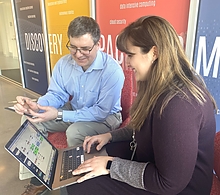
Mihai Pop, a professor of computer science and director of the University of Maryland Institute for Advanced Computer Studies (UMIACS), was recently awarded a $2.6 million federal grant to develop a suite of computational tools for reconstructing DNA segments.
The four-year award comes from the National Institute of Allergy and Infectious Diseases, which is part of the National Institutes of Health. The money supports efforts to build software and develop algorithms that can reconstruct nearly-complete microbial genomes from complex mixtures found in environments like the human gut. Ultimately, researchers say, this will help scientists better understand the role that certain microbes have in human health and disease.
Pop (left in photo) is principal investigator of the project, and will be assisted by postdocs and graduate students in the Center for Bioinformatics and Computational Biology (CBCB), as well as software experts in the Fraunhofer USA Center for Experimental Software Engineering.
“We want our software to be well-written and usable by biologists across many different computing platforms, so Fraunhofer will help us greatly with that software engineering aspect,” Pop says.
Recent years have seen a “metagenomic revolution” made possible by rapid advances in sequencing technologies, explains Pop. Metagenomics involves the application of bioinformatics tools to study the genetic material from environmental, uncultured microorganisms.
To date, hundreds and possibly thousands of microbial communities have been characterized through deep sequencing, complementing the wealth of data that has already been generated through the targeted sequencing of individual genes.
These studies have started to shed light on the broad functional potential of microbial communities, Pop adds, even though the individual microbes cannot be easily isolated and analyzed in the laboratory.
But despite these advances, relatively few genome sequences have been generated through metagenomic methods. Even those sequences have had a limited impact on the scientific community due to concerns about the quality of reconstruction and inability to assign taxonomic labels to sequences not derived from isolated genomes.
“We want to better understand processes that usually can’t be seen until the bacteria is isolated,” Pop says. For example, he asks, “What if you have two different strains of E.coli in your gut, what is the difference between them, and why does that variance matter?”
In some of the samples his group has been looking at, certain bacteria have acquired antibiotic-resistance genes. This can turn some bacteria into harmful entities, even though they normally wouldn’t be. The software suite Pop’s team is developing will hopefully offer insight into this phenomenon.
“Just being able to generate more data to better understand how bacteria react to each other is a large part of the project,” says Jaquelyn Meisel (right in photo), a postdoctoral associate in CBCB.
“We might be able to identify that this patient has a resistant bacterium that came from some other bacteria that the patient has, or maybe it’s environmental,” Meisel explains. “Once you’re able to track variance, you might be able to say, ‘well I saw this variance somewhere else and now I see it here.’”
Looking ahead, Pop and his team see their work as an important step in helping other scientists and clinicians determine how both good and bad bacteria move through environments, inside and outside of the human body.
“In a cultural context, we want to know when antibiotic-resistant genes get into the food stream,” Pop says. “We know that if you feed animals antibiotics, eventually you see the same bacterium in humans with that resistance. But we don’t have a very clear path of transmission. These tools will hopefully start developing that chain of transmission.”
—Story by Maria Herd
Research by Colwell Sheds New Light on Flesh-Eating Bacteria
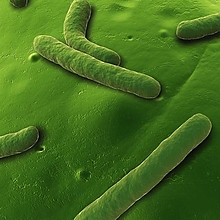
This story was originally published in Maryland Today.
A few years ago, a patient fell into a body of freshwater, gashed a leg on a rock and developed a quickly spreading infection that began eating into flesh, a condition known as necrotizing fasciitis. Unable to bring the disease under control any other way, doctors took drastic measures, and the patient (whose personal details can’t be disclosed) suffered a quadruple amputation.
Although the infection was originally diagnosed as the work of a single microbe, a new study of the case by a team of scientists that included Distinguished University Professor Rita Colwell used genetic analysis to reveal how two different strains of a single species of flesh-eating bacteria worked in concert to become more dangerous than either strain alone.
The study, which could lead to better medical care for patients with multi-microbial flesh-eating infections, was published on November 12 in the Proceedings of the National Academy of Sciences.
“When we treat with a given antibiotic, we’re clearing an organism out of the body,” said Colwell, an expert of global stature on infectious diseases who holds appointments in the University of Maryland Institute for Advanced Computer Studies (UMIACS) and at the Johns Hopkins University Bloomberg School of Public Health. “But if there’s another organism that’s participating in the infection and that’s also pathogenic, then any antibiotic treatment that doesn’t also target that organism may just be clearing ground for it to grow like crazy.”
Traditional diagnostics could only determine that the patient’s infection was caused by a single species of bacteria called Aeromonas hydrophila. But the disease baffled clinicians when it rapidly turned life-threatening. Through genetic analysis of the culture, Colwell and her team discovered important differences among the individual bacterial cultures that could not be detected through standard diagnostic methods.
In addition to Colwell, Nur A. Hasan, an adjunct associate professor in UMIACS, is a co-author on the paper. He as the chief science officer for CosmosID Inc., a company that Colwell founded and chairs, and which performed metagenomic analysis for this study. The team also included co-authors from the University of Texas Medical Branch.
Both Colwell and Hasan are part of the Center for Bioinformatics and Computational Biology, one of seven major centers in UMIACS.
In two previous papers, Colwell and her colleagues isolated and identified two genetically distinct strains of the bacteria that combined to cause necrotizing fasciitis. In the current study, the researchers manipulated the genetic components of each strain. When they swapped the genetic components that varied between the strains, the team was able to make them behave similarly. By testing the mutant strains in mice, the team determined how the genetic variations affected each strain’s ability to cause infection and interact with the other strain.
The three studies combined paint a clear picture of how the strains, labeled NF1 and NF2, behave both in separate infections and when combined. In single-strain infections, NF1 remains localized, does not spread to the bloodstream or organs and is cleared by the host immune system. NF2, however, produces a toxin that breaks down muscle tissue and allows it to spread to the bloodstream or organs.
When the strains occur together, the story is reversed. In multi-strain infections, the toxin produced by NF2 breaks down the muscle tissue and enables NF1 to travel to the bloodstream or organs where it becomes deadly.
“We’re excited by this very elegant detective work,” Colwell said. “We now have the ability through metagenomics to determine the individual infectious agents involved in polymicrobial infections. With these powerful new methods we can determine how microbes work together, whether they’re bacteria, viruses or parasites.”
—Story by Kimbra Cutlip
Colwell Reflects on Global Water Issues
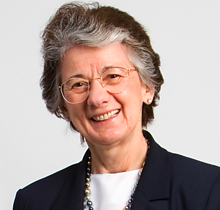
Rita Colwell, a Distinguished University Professor in the University of Maryland Institute for Advanced Computer Studies, recently gave the keynote address at a campus forum discussing the health of the Chesapeake Bay.
“Ensuring a Clean and Healthy Chesapeake Bay” featured experts on storm water management, water use and reuse, the bay’s aquatic life, and more.
Before speaking at the forum, Colwell sat for an interview with Samantha Watters, assistant director of communications for the College of Agriculture & Natural Resources.
Q: What do you see as the biggest challenges facing humanity today and how have they helped advance your thinking and professional pursuits?
A: The biggest challenge is water, it really is. Right now, we are fighting over oil, but we’ve already got fights going on over water, who gets to use it, and this clearly is an agricultural problem. It’s a negotiation that has to be done between community use, agricultural use, and water recycling that is necessary for sustainability. It’s a tradeoff between water for drinking, domestic use, agricultural application, industry, recreation, you name it. And the assumption is that since 70 percent of the earth is covered with oceans, we must have plenty of water, but that water isn’t really available. Also, the tragedy of dealing with climate change means the glaciers are melting, and it’s a real problem because these glaciers feed freshwater drinking systems. We are going to be seeing huge climate change migrations away from areas drastically affected, and exacerbation of political problems that are all intertwined and connected by water.
Q: How does interdisciplinary science enter into solving these global issues?
A: Science has done a great job over the years tackling issues of reductionism—reducing problems to the molecular level, the galaxy level, and so on. But now, to solve the issues our planet is facing, we will need to be thinking at a much more holistic level. And agriculture is a prime example of the necessity of integration—it is a very complex system. The issues are complex, but they are solvable, and collaboration and machine learning can help us get there. It will be interesting to see what can come out of the analysis of interdisciplinary work across all these systems with the rise of big data approaches. Agriculture has the challenge of maintaining the small farm while figuring out how to feed the expanding population. It’s a problem that is an aspect of the global world and crossing disciplines and data integration is the only way.
Q: In what ways do you feel that current and future water scientists can make an impact in a changing world, with a changing climate and changing priorities?
A: It’s not how or when, they just have to. It’s a sheer necessity. It’s not just knowing how much and where, but it’s how to allocate usage of water and how to share with competing priorities. The focus should really be on recycling processes to protect and reuse our water. We can apply biotechnology to our sewage treatment systems to not only clean the water but produce enough power through bioreactors to heat and light cities. We have to go forward to figure out how to apply the sciences of computation agriculture, water reuse, recycling, and engineering to integrate these systems in daily life. Ensuring water systems and a clean and healthy Chesapeake Bay is far more complicated than just making sure you can see the bottom. It’s understanding that the Chesapeake Bay is a prime example of a resource that has to be protected and used in a sustainable way. It’s the only one we’ve got, and the history of the Bay and the resources are well worth protecting.
Q: What advice would you give the next generation of young scientists, policy makers, economists, and leaders hoping to make a difference in water quality and environmental stewardship?
A: The career you’ve planned is going to change many times, and you will have to constantly be relearning. You have to follow your interests—if you don’t really like what you’re doing, you won’t persevere. Also, it’s kind of a shame to be totally focused as a freshman and not sample other disciplines. Literature and art are sources of creativity as well as sources of satisfaction and stress release, and it makes you a stronger scientist. It’s a huge richness of the human spirit and human knowledge. For me, it gets a bit worrisome when a university experience becomes a training center rather than a learning center. You really have to develop the skills to be innovative and flexible in your studies and to keep an open mind in your career. The nature of life is change and thinking broadly keeps you receptive as a scientist and human being to new ideas.
Q: When you look back on such a decorated career, what have been your proudest moments and why?
A: My proudest moments are my two children and my grandchildren. I’ve been very fortunate that I was married to my husband, who was a physicist, for 62 years. And my two daughters are scientists, a botanist and a pediatrician. And the University of Maryland has been very good to me. I’ve loved being here. It’s a very progressive state and university. I’ve been able to do a lot of things here that I wouldn’t have necessarily been able to do in another institution.CBCB Graduate Student Receives 2019 Outstanding Graduate Assistant Award
Brian Brubach, a graduating computer science doctoral student working in the Center for Bioinformatics and Computational Biology (CBCB), is the recipient of the 2019 Graduate School Outstanding Graduate Assistant (GA) Award.
This award recognizes the “outstanding contributions that these GAs provide to students, faculty, departments, administrative units, and the University as a whole.”
He is also a 2019 finalist for the UMD Graduate Student Distinguished Service Award, which celebrates graduate students who have made outstanding contributions to the University community in the areas of service, involvement, leadership and scholarship.
Brubach’s research interests include algorithms and theoretical computer science, bioinformatics, e-commerce, and fairness in machine learning.
He is co-advised by Aravind Srinivasan, a professor of computer science with an appointment in the University of Maryland Institute for Advanced Computer Studies (UMIACS), and Mihai Pop, a professor of computer science and director of UMIACS.
Summer Interns Burst Into the World of Bioinformatics and Computational Biology
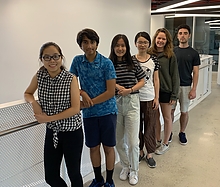
A group of six students are spending much of this summer in the Center for Bioinformatics and Computational Biology (CBCB), collaborating with University of Maryland faculty and graduate students on projects ranging from identifying novel viruses to utilizing synthetic lethality to improve cancer treatments.
The students—who range from a rising college senior to a rising high school junior—are part of a 10-week long internship run by faculty in CBCB, with additional support coming from Illumina, a U.S. company focused on developing genomic analysis tools.
“We’ve been doing this for several years and find it valuable for our faculty and the students involved—both the visiting students and our own graduate students,” says Michael Cummings, a professor of biology and the director of CBCB.
The goal of the program, Cummings says, is to give young scientists a hands-on research experience in bioinformatics, letting them work side-by-side with faculty on complex research problems being investigated in CBCB.
Tracy Chen, a second-year UMD computer science doctoral student who is leading the interns, says she enjoys working with the “incredibly talented” group of students.
“I enjoy having one-on-one meetings with the interns every week to learn their research status and also what’s going on in their life, as well as organizing weekly internship seminars,” she says. “When the program finishes next month, I hope our interns will have learned more aspects of bioinformatics through our seminars in addition to their focused research areas. And since our interns come from different schools, I also hope they are making friends from across the country.”
Marie Crane, a rising senior majoring in biology at Macalester College in St. Paul, Minnesota, says CBCB’s program was a perfect fit since she was searching for an internship in computational biology or bioinformatics.
Crane is working with Mihai Pop, a professor of computer science and director of the University of Maryland Institute for Advanced Computer Studies (UMIACS), to develop a method to identify novel viruses. Specifically, she is working with metagenomic data from the hot springs at Yellowstone National Park.
“Participating in this program has been challenging in a good way for me,” Crane says. “I’ve been able to use more computational methods and learn more about coding than previous internships I’ve had. The resources I have had access to at CBCB have also been really helpful in completing my research.”
She adds that she feels lucky to be collaborating with Pop.
“Working with Mihai is great,” Crane says. “He is a very big figure in the field, so it is definitely a privilege to be able to work with him this summer.”
Jessica Pan, an incoming freshman at Yale University, says she felt compelled to apply for the program because of how CBCB is combining classical biology with new technologies. She is specifically interested in how these new advances are impacting the medical field.
“They’re really pioneering the way here,” Pan says. “I love the professors and my co-workers—it’s just a really incredible place to work.”
Pan is working on a project involving a gene-pair relationship called synthetic lethality, in which inactivation of both genes is lethal to a cell, but inactivation of one gene by itself is not. In cancer cells where mutations inactivate one gene, drugs inhibiting the partner gene would be lethal to cancer cells but have minimal or no effect on healthy tissue in which the first gene is expressed normally.
“That’s really important because with things like chemotherapy and typical radioactive treatments, you’re harming a lot of the patient’s healthy cells while you’re trying to kill the cancerous cells,” Pan says. “So this is a really great way to minimize the side effects and the adverse impact of cancer therapy. It’s a pretty new field, but it’s one that I find really interesting.”
Her mentor is Sridhar Hannenhalli, a professor of cell biology and molecular genetics.
“Dr. Hannenhalli is really engaged and involved,” she says. “Whenever we have any issues, he is always available to talk. In previous internships I’ve had, that has not really been the case. It’s nice that we are getting so much guidance from the people running this program.”
Other students participating in the CBCB program this summer are: Camilo Calvo-Alcaniz, a rising senior double majoring in computer science and pre-medicine at UMD; Kassie Wang, an incoming freshman at Cornell University; Hyeyun Chae, a rising junior double majoring in biology and computer science at Swarthmore College; and Rajit Mukhopadhyay, a rising junior at Montgomery Blair High School.
At the end of the summer, the six interns will put together a report outlining the results of their research and give a short presentation about their projects.
—Story by Melissa Brachfeld
From left in photo: Kassie Wang, Rajit Mukhopadhyay, Jessica Pan, Tracy Chen, Marie Crane and Camilo Calvo-Alcaniz. Not pictured: Hyeyun Chae.
Scientists Identify New Genetic Interactions that May Impact Cancer Outcomes
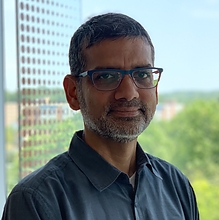
Living cells contain tens of thousands of genes that serve as instruction guides for making the proteins cells need to survive. These genes function in highly cooperative and interdependent ways, and scientists have long known that a change in the expression of one gene can affect how other genes function. These interdependencies can impact a cell’s ability to survive.
In a new study, scientists at the University of Maryland and the National Cancer Institute identified 12 distinct types of gene-pair interactions in which varying levels of expression in the two genes correlated with cancer patient survival. The results, which were published in the journal Cell Reports on July 23, 2019, suggest that genes involved in such paired interactions could provide new targets for cancer therapy.
“Relying on specific cancer vulnerabilities, such as a particular mutated gene’s functional relationship with other genes, is potentially an effective approach to treating cancer,” said the study’s senior author Sridhar Hannenhalli (in photo), a professor in the Department of Cell Biology and Molecular Genetics at UMD.
This approach is already being explored in one type of gene-pair relationship called synthetic lethality, in which inactivation of both genes is lethal to a cell, but inactivation of one gene by itself is not. In cancer cells where mutations inactivate one gene, drugs inhibiting the partner gene would be lethal to cancer cells but have minimal or no effect on healthy tissue in which the first gene is expressed normally.
This new work revealed a broad spectrum of important gene-pair relationships in addition to synthetic lethality. Many of these new relationships were more abundant in the researchers’ data than synthetic lethality, which means they may offer many more potential targets for cancer therapy.
“Our work expands the potential scope of strategies, thus far restricted to synthetic lethality, by generalizing the concept of exploiting genetic interactions to include many other yet unexplored types of gene-pair relationships,” said Hannenhalli, who has a joint appointment in the University of Maryland Institute for Advanced Computer Studies (UMIACS). “We believe this lays the foundation for using a computational method for identifying and studying additional types of genetic interactions in the future.”
The paper presents a new, data-driven method for identifying gene interactions that could impact cancer patient outcomes, which Hannenhalli developed in collaboration with former UMD graduate student Assaf Magen (Ph.D. ’19, computer science), the first author of the study, and Eytan Ruppin, currently at the National Cancer Institute and the former director of the Center for Bioinformatics and Computational Biology at UMD.
Using data from 5,288 tumors representing 18 different cancer types, the team defined six interactions in which each gene in a pair could be expressed at a low, medium or high level. They then considered that each of those combinations could be associated with a “positive” or “negative” outcome for patient survival. That brought the total number of potential gene-pair relationship types to 12.
Using a novel computational strategy, the researchers assessed all possible combinations of genes in their dataset. Out of 163 million potential gene pairs, the researchers identified nearly 72,000 gene-pair interactions associated with a positive or negative patient survival. Of the genes involved in these interactions, a significant proportion are known to be involved in cell division and proliferation, which have clear links to cancer.
According to Hannenhalli, identifying gene-pair relationships can help scientists understand why mutations in certain genes lead to cancer in one tissue but not another, because their interacting partners might be expressed differently in different types of tissue. Similarly, gene-pair relationships could explain why certain drugs are effective for one patient but not another. The relationships also might help researchers identify subtypes of certain cancers, such as breast cancer, which may help with prognosis and therapy.
Using their findings on gene-pair interactions, the researchers were able to better predict patient outcomes in their data on tumor gene expression, compared with conventional methods that use expression of individual genes alone.
Hannenhalli stressed that there is still much work to be done to identify which gene pairs actually have a direct impact on cancer patient survival. The next step, he said, is to collaborate with cancer biologists or clinicians to begin experimenting with therapies targeted at some of the gene pairs identified in this study.
###Additional co-authors of the research paper who conducted the work while at UMD include former postdoctoral fellows Avinash Das and Joo Sang Lee, former graduate student Mahfuza Sharmin (Ph.D. ’17, computer science), and computer science undergraduate Alexander Lugo.
This work was supported by the Intramural Research Program of the National Institutes of Health’s National Cancer Institute and the National Science Foundation (Award No. 1564785). The content of this article does not necessarily reflect the views of these organizations.
The research paper, “Beyond Synthetic Lethality: Charting The Landscape of Pairwise Gene Expression States Associated with Survival in Cancer,” Assaf Magen, Avinash Das, Joo Sang Lee, Mahfuza Sharmin, Alexander Lugo, Silvio Gutkind, Alejandro A. Shaffer, Eytan Ruppin, Sridhar Hannenhalli, was published in Cell Reports on July 23, 2019.
Two UMIACS-Affiliated Researchers Receive Presidential Early Career Awards

Two researchers affiliated with the University of Maryland Institute for Advanced Computer Studies (UMIACS) have been awarded the Presidential Early Career Award for Scientists and Engineers (PECASE), the highest honor bestowed by the U.S. government on scientists and engineers in the early stages of their careers.
Alexey Gorshkov, a Fellow in the Joint Center for Quantum Information and Computer Science (QuICS), and Adam Phillippy, who did his doctoral work in the Center for Bioinformatics and Computational Biology (CBCB), are among 315 researchers nationwide to receive a PECASE award.
The awards, established in 1996, are coordinated by the Office of Science and Technology Policy within the Executive Office of the President. Awardees are selected on the basis of two criteria: Pursuit of innovative research at the frontiers of science and technology, and a commitment to community service as demonstrated through scientific leadership, public education or community outreach.
“Alexey and Adam exemplify the important role that talented young researchers will have in solving many of the scientific and societal challenges we face today,” says Mihai Pop, a professor of computer science and director of UMIACS. “Our research community is proud to work with both of them.”
Gorshkov, a physicist in the Quantum Measurement Division of the National Institute of Standards and Technology (NIST), will receive the PECASE award for his pioneering work on understanding and controlling quantum systems, especially large and interacting ones.
At Maryland, Gorshkov leads a theoretical research group working at the interface of quantum optics, atomic and molecular physics, condensed matter physics and quantum information science.
In addition to his role at QuICS and with NIST, Gorshkov is an adjunct associate professor in the Department of Physics and a Fellow in the Joint Quantum Institute.
He recently chaired a workshop on Noisy Intermediate-Scale Quantum Technologies. The two-day event focused on the applications and benchmarking of quantum computers that are likely to be built in the near term—those that are too big to simulate classically but also too small to run the killer apps of quantum computation.
Phillippy is head of the Genome Informatics Section and a tenure-track investigator in the Computational and Statistical Genomics Branch at the National Human Genome Research Institute.
He received a PECASE award for his pathbreaking work on single-molecule DNA sequencing that is allowing for the assembly of complete genome sequences. Such assembly will help finish the remaining gaps in the human reference genome, which has a clear benefit to the study of genetic disorders.
From 2006 to 2010, Phillippy worked in CBCB with Steven Salzberg and others, researching new methods for pathogen detection using PCR, microarrays and DNA sequencing.
Previously, Phillippy had worked at the Institute for Genomic Research under the supervision of Pop, where they collaborated on developing several foundational tools for genome assembly and alignment.
